
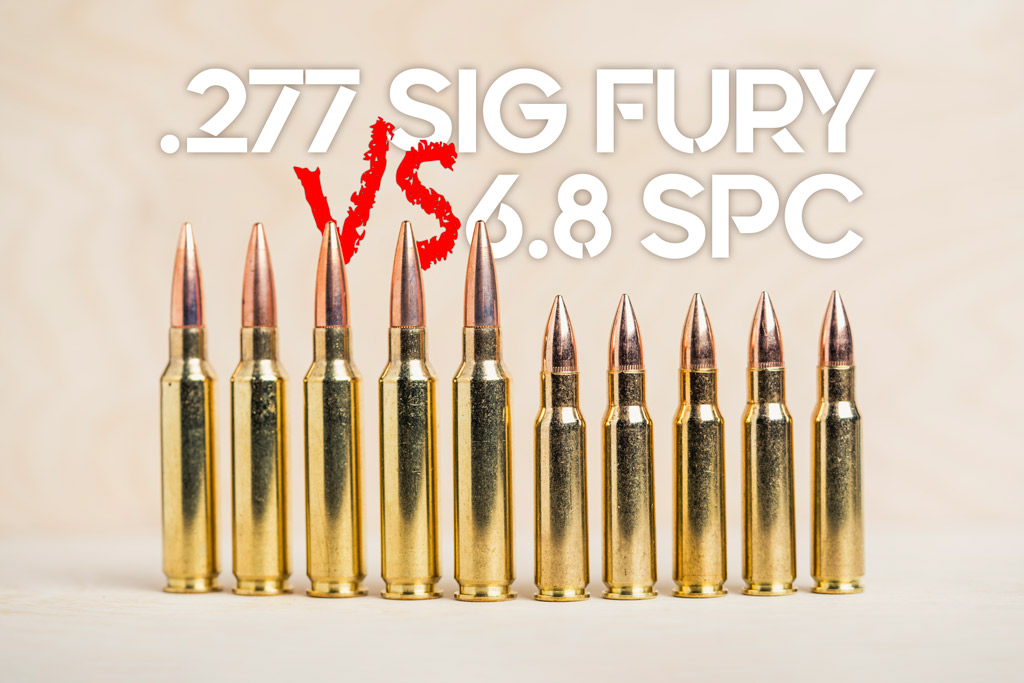
If you’re as excited about modern rifle cartridges as we are, you’ve probably jumped into debates around 277 Fury VS 6.8 SPC. Both cartridges owe their existence to the U.S. military. Their creation came about due to the battlefield limitations of the 5.56 NATO round. While both are designed to outperform the aging 5.56 NATO round, they do so by taking different paths.
The .277 Sig Fury is the U.S. Army’s new go-to battle rifle cartridge. It was specifically designed as part of the Army’s Next Generation Squad Weapon Program. The 6.8 SPC evolved from the needs of the Army’s Marksmanship Unit. It’s seen plenty of action on the battlefield, however, it’s more known these days for its popularity with civilian hunters, and AR-15 owners.
On paper, it’s hard to tell which cartridge performs the best. Whether you’re a seasoned shooter or a newbie looking for insights, we’ve got you covered. Let’s break down these two contenders and see how they stack up.
277 Fury VS 6.8 SPC
Let’s take a quick look at the differences. 6.8 SPC is a different cartridge than the .277 Sig Fury. The 6.8 SPC cartridge measures 6.8x43mm and was designed to be compatible with the AR-15 rifle platform. The larger .277 Sig Fury measures 6.8x51mm and is too large for the AR-15 rifle platform. You’ll need to bump up to an AR-10 style rifle (or Sig MCX) to have compatibility with the .277 Sig Fury.
In terms of ballistics, the .277 Sig Fury bullet has more velocity (capable of 3,000+ FPS), and more energy (capable of 3,000+ FT LBS) than the 6.8 SPC. This is partially because the .277 Sig Fury has a longer case length. This allows it to hold more powder and withstand a higher maximum pressure at 80,000 PSI. Whereas the smaller 6.8 SPC cartridge tops out at 55,000 PSI.
| Cartridge Specs | .277 Fury | 6.8 SPC |
|---|---|---|
| Parent Casing | None | .30 Remington |
| Bullet Diameter | .278″ | .277″ |
| Neck Diameter | .310″ | .306″ |
| Base Diameter | .470″ | .422″ |
| Case Length | 2.015″ | 1.687″ |
| Overall Length | 2.825″ | 2.260″ |
| Grain Weight | 130gr-150gr | 75gr-120gr |
| Max Pressure (SAMMI) | 80,000 PSI | 55,000 PSI |
Dimensions for the .277 Sig Fury:
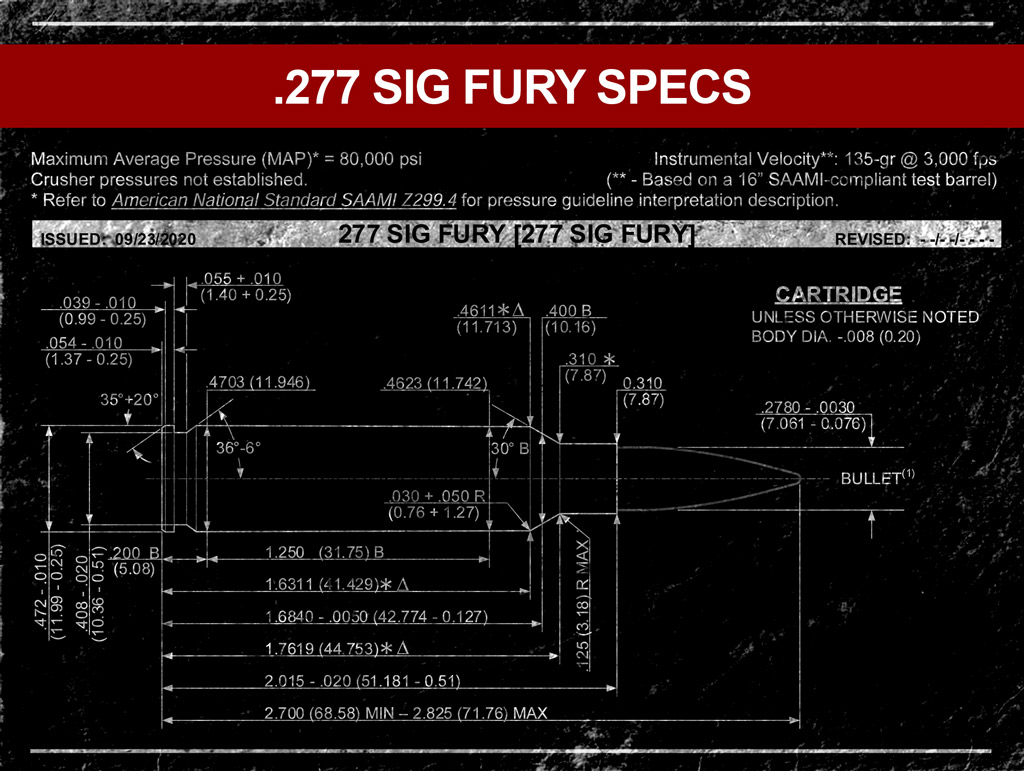
The .277 Sug Fury design is an example of engineering advancements in size, weight, and propellant.
- Designed: 2019
- Designer: Sig Sauer
- Type: Centerfire Rifle
- Case capacity: 54gr H2O
Dimensions for the 6.8 SPC:
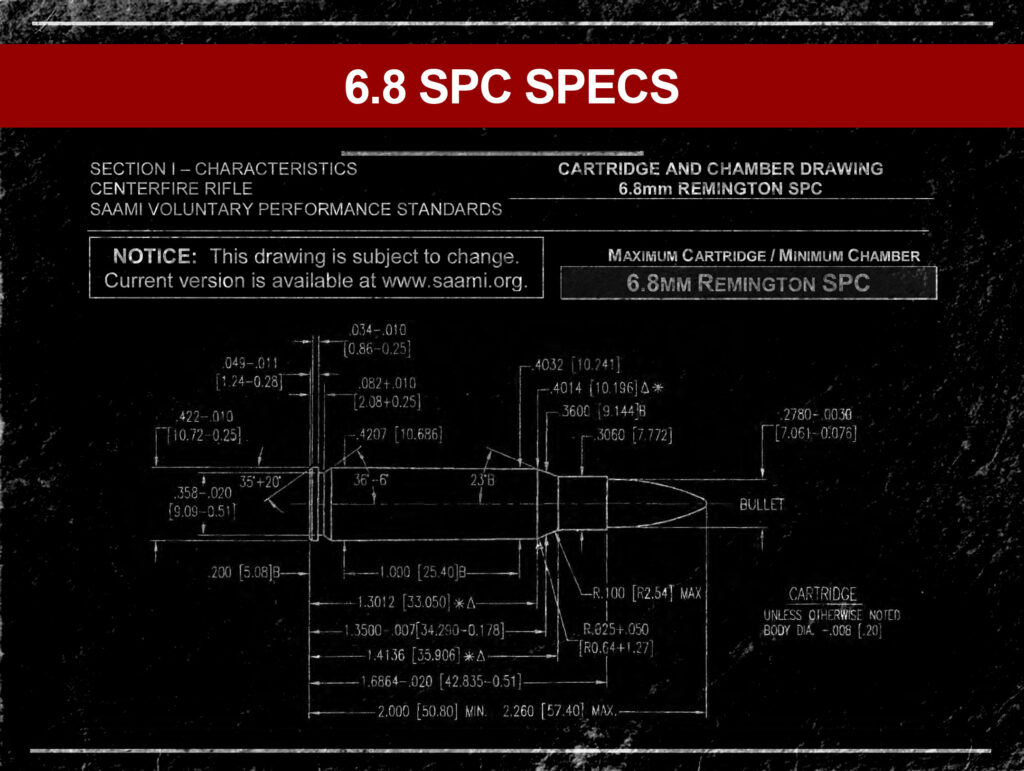
The 6.8 SPC is a popular niche in the lineup of centerfire rifle cartridges.
- Designed: 2002-2004
- Designer: Remington Arms
- Type: Centerfire Rifle
- Case capacity: 34.8-36.9GR H2O
History: 277 Fury VS 6.8 SPC
Both the .277 Fury and the 6.8 SPC have been in the limelight, each staking its claim in the firearms community. Although both were created for military applications, they’ve become sought-after rounds in the civilian market. Let’s take a look at their unique histories below.
.277 Sig Fury History
The .277 Fury is a relatively new kid on the block, created by SIG Sauer for U.S. Army applications. This cartridge has one primary goal: to outpace the performance of existing infantry rifle rounds while still being usable in short-action rifles. It’s the same case length (2.015″) as the established 7.62×51 NATO round, with its extra length attributed to the elongated .277 bullet (similar to the 7mm-08 Rem).
Its unique “hybrid” casing consists of three parts: A stainless steel base, an aluminum locking washer, and a brass casing. Sig claims that these hybrid cases have a higher yield strength, allowing them to handle higher maximum pressures, increasing performance and reliability (standard brass, low-pressure cases for the civilian market also exist). When comparing it to similar military cartridges: In terms of size, it sits above the 5.56 NATO, and barely above the 7.62×51 NATO. In terms of ballistics, it sits above the 5.56 NATO in energy, but is slightly below it in average velocity. It sits above the 7.62×51 NATO with slightly more muzzle energy and velocity on average.
6.8 SPC History
A bit older in origin, the 6.8 SPC (Special Purpose Cartridge) came about in the early 2000s with collaboration from the U.S. Army Marksmanship Unit. Its aim? To rectify the perceived deficiencies of the 5.56 NATO round, especially in short-barreled rifles. The 6.8 SPC never caught on with the masses, or at least not to the degree that its developers had hoped. But it is still a great round that offers some definitive advantages over the 5.56 NATO.
Despite being based on the .30 Rem cartridge, the 6.8 SPC is very close in size to the 5.56 NATO round. Its .277 bullet diameter (same as the .270 Win) is closer in size to the 7.62×51 NATO round, but its performance more closely resembles the 6.5 Grendel. When comparing it to similar military cartridges: In terms of size, it sits between the 5.56 NATO, and the 7.62×51 NATO. In terms of ballistics, it sits just below the 5.56 NATO, and the 7.62×51 NATO, in both muzzle energy and velocity.
Ballistic Comparison: 277 Fury VS 6.8 SPC
Now that we’ve gotten the history lesson out of the way, let’s get to what you really care about, performance! A cool origin story is great and all, but ballistics are what really matter the most. The ballistic data below was recorded using a 16″ rifle barrel. Keep in mind the numbers below will differ based on the type of ammunition you’re using, the length of the gun barrel, and weather/wind conditions.
277 Fury
The Fury’s claim to fame is its unique three-piece case design, which allows it to operate at higher pressures than traditional brass-cased ammunition. This translates into faster muzzle velocities and, consequently, flatter trajectories. The cartridge has showcased its ability to deliver consistent performance over various distances, making it a versatile choice.
6.8 SPC
With its roots in enhancing close-quarters battle performance, the 6.8 SPC offers increased bullet weight and improved ballistics over the 5.56 NATO. Many users laud it for its balanced attributes, giving a good blend of range and stopping power. However, the .277 Fury outperforms it at longer distances.
Standard Ballistics

277 Fury VS 6.8 SPC: Full metal jackets offer similar performance, but the .277 Fury maintains a competitive edge.
The 135gr FMJ in .277 Sig Fury is a solid performer. It hits 2,750 FPS in muzzle velocity leaving the 16 inch barrel, with an impressive 2,267 FT LBS of energy. Bullet energy stays well over 1,200 FT LBS out to 300 yards and beyond, giving it more stopping power than the 6.8 SPC bullet. Bullet drop is even at 100 yards and only 10.8 inches at 300 yards, showing off its impressive flat trajectory.
For a S&B 110-grain 6.8 SPC cartridge, you’ll get a respectable muzzle velocity of 2,556 FPS, and 1,767 FPS at 300 yards. The energy will be about 1,500 FT LBS at the muzzle, dropping all the way to 763 FT LBS at 300 yards. Bullet drop is negligible at 100 yards and falls 18.1 inches at the 300 yard mark.
| Caliber | Bullet Type | Bullet Weight | Velocity (Muzzle) | Energy (Muzzle) | 100 Yards (Velocity/Energy) | 200 Yards (Velocity/Energy) | 300 Yards (Velocity/Energy) |
|---|---|---|---|---|---|---|---|
| .277 Sig Fury | FMJ | 135gr | 2,750 FPS | 2,267 FT LBS | 2,561 FPS/1,965 FT LBS | 2,379 FPS/1,697 FT LBS | 2,205 FPS/1,457 FT LBS |
| 6.8 SPC | FMJ | 110gr | 2,556 FPS | 1,595 FT LBS | 2,275 FPS/1,264 FT LBS | 2,013 FPS/989 FT LBS | 1,767 FPS/763 FT LBS |
Hunting Ballistics
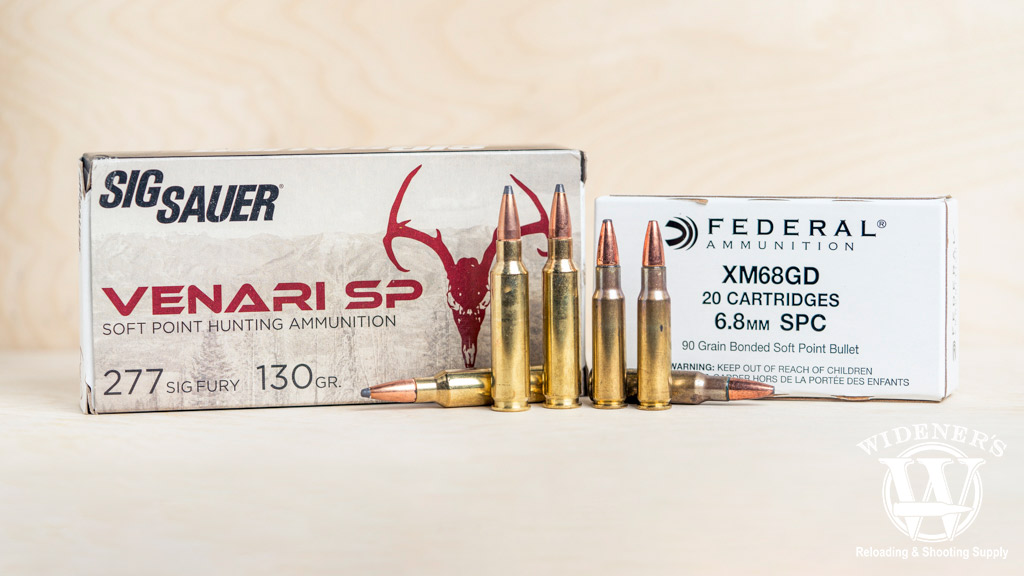
In the hunting ammo category, the .277 Sig Fury leaves the 6.8 SPC in the dust at 300 yards and beyond.
The 130gr SP in .277 Sig Fury is a hunter’s dream. It hits 2,710 in muzzle velocity leaving a 16 inch barrel, with an impressive 2,120 FT LBS of energy. Bullet energy stays well over 1,000 FT LBS to 300 yards and beyond, giving it more power to drop a deer at a distance than the 6.8 SPC. Bullet drop is zero at 100 yards and it remains respectable, dropping 11.9 inches at 300 yards.
For the 90gr Federal round in 6.8 SPC, you’ll get a muzzle velocity of 2,605 FPS and 2,089 FPS at 300 yards. The energy will be about 1,355 FT LBS at the muzzle, dropping to 581 FT LBS at 300 yards, trying to take a deer beyond that range is questionable with this specific cartridge. Bullet drop is negligible until 300 yards when it falls about 15 inches below the point of aim.
| Caliber | Bullet Type | Bullet Weight | Velocity (Muzzle) | Energy (Muzzle) | 100 Yards (Velocity/Energy) | 200 Yards (Velocity/Energy) | 300 Yards (Velocity/Energy) |
|---|---|---|---|---|---|---|---|
| .277 Sig Fury | SP | 130gr | 2,710 FPS | 2,120 FT LBS | 2,493 FPS/1,794 FT LBS | 2,286 FPS/1,508 FT LBS | 2,089 FPS/1,259 FT LBS |
| 6.8 SPC | SP | 90gr | 2,605 FPS | 1,355 FT LBS | 2,285 FPS/1,043 FT LBS | 1,985 FPS/787 FT LBS | 1,705 FPS/581 FT LBS |
Performance Ballistics

The competition performance category goes to the .277 Sig Fury, but it’s a close one.
The 150gr poly-tip “hybrid” .277 Sig Fury cartridge is a beast. It hits 2,830 in muzzle velocity leaving a 16 inch barrel, with a mighty 2,667 FT LBS of energy. Bullet energy stays well over 1,500 FT LBS to 300 yards and beyond, giving it almost double the stopping power of the 6.8 SPC bullet. Bullet drop is zeroed at 100 yards and only falls 9.6 inches at 300 yards.
For a 110-grain Hornady Black cartridge in 6.8 SPC, you’ll get a muzzle velocity of 2,550 FPS and 1,893 FPS at 300 yards. The energy will be just under 1,600 FT LBS at the muzzle and 875 FT LBS at 300 yards. Bullet drop is solid, it only falls 10.4 inches below the point of aim at 300 yards.
| Caliber | Bullet Type | Bullet Weight | Velocity (Muzzle) | Energy (Muzzle) | 100 Yards (Velocity/Energy) | 200 Yards (Velocity/Energy) | 300 Yards (Velocity/Energy) |
|---|---|---|---|---|---|---|---|
| .277 Sig Fury | Poly | 150gr | 2,830 FPS | 2,667 FT LBS | 2,676 FPS/2,333 FT LBS | 2,471 FPS/2,033 FT LBS | 2,302 FPS/1,764 FT LBS |
| 6.8 SPC | Poly | 110gr | 2,550 FPS | 1,588 FT LBS | 2,319 FPS/1,313 FT LBS | 2,100 FPS/1,077 FT LBS | 1,893 FPS/875 FT LBS |
Usability & Compatibility
Since it’s a newer round, firearms chambered explicitly for the .277 Fury are harder to come by, but they (semi-auto, and bolt-action options) are out there. In theory, the .277 Fury is compatible with the AR-10 rifle platform, meaning that by swapping out the barrel and bolt on your AR-10, you should be able to safely run low-pressure, civilian market brass .277 Fury ammo.
However, keep in mind that the .277 Fury cartridge has an extremely high max pressure (80,000 PSI). The “hybrid” high-pressure .277 Fury military rounds are loaded much hotter than the brass civilian cartridges. For safety reasons, it’s important that you know the maximum port/chamber pressure that your AR-10 rifle can handle, and don’t overload it. When in doubt, contact the manufacturer, or your local gunsmith before proceeding.
Given its longer tenure, there’s a broader market for 6.8 SPC-chambered firearms. For AR-15 enthusiasts, switching to 6.8 SPC often requires a new bolt and barrel, making the transition relatively painless. You’ll have a much easier time finding 6.8 SPC components for your AR. Plenty of finished uppers come chambered in 6.8 SPC if you don’t want to do the barrel swap yourself. It doesn’t get much easier than that.
Ammo Futures: 277 Fury VS 6.8 SPC
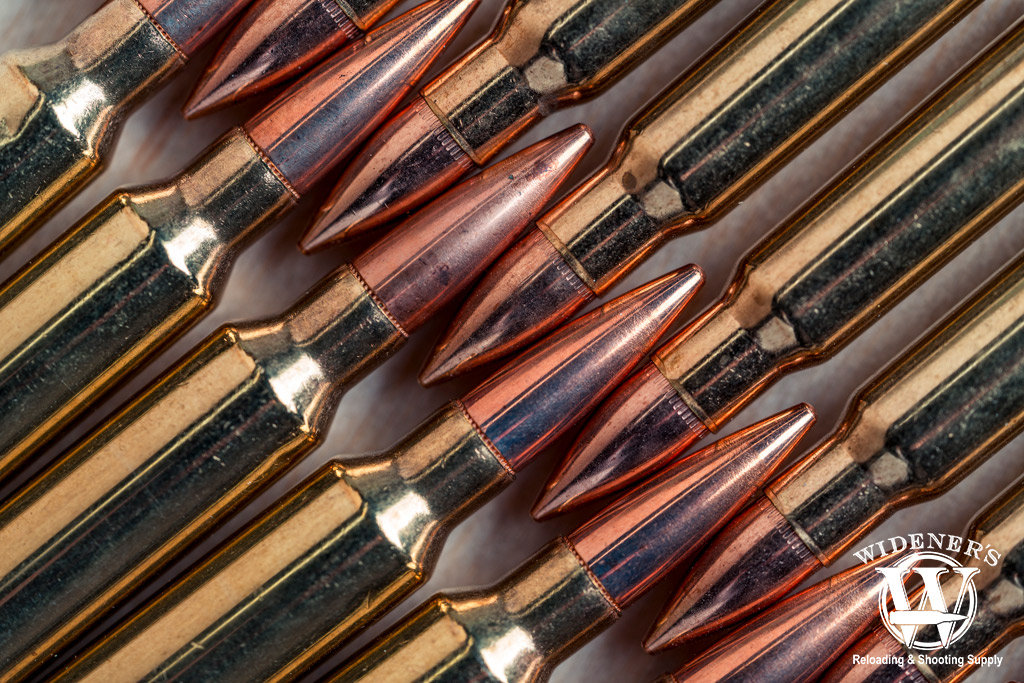
.277 Sig Fury (Left) has a bright future ahead, while the 6.8 SPC (Right) has settled in as a popular niche for AR-15 owners.
The 6.8 SPC has been around for over a decade and is here to stay. While no one can know if the .277 Fury will build its own loyal following, things are looking good so far. Here’s a glimpse into the future of both cartridges.
.277 Fury
Given its recent entry and SIG’s push for its adoption in military trials, the future looks bright for the .277 Fury. If it gets the nod from defense forces, expect it to gain substantial traction. Even if it doesn’t, some gun owners love to follow the newest fads and will undoubtedly become fierce .277 Fury loyalists (Looking at you, 6.5 Creedmoor).
6.8 SPC
While it didn’t become the military standard it initially intended, the 6.8 SPC has found love among hunters and sport shooters. Its established foothold ensures it won’t be fading anytime soon. And there is a vast selection of products, from finished rifles to barrels and BCGs. Oh, and the ammo is easier to find.
Cost & Availability
So, what will it cost you to get these rounds? Can you even find them? Being newer and having a unique case design means the .277 Fury is generally pricier than conventional rounds. As for availability, while it’s gaining traction, it may not be as readily available as some other cartridges.
Having been around for almost two decades, the 6.8 SPC is more widely available, and options in terms of manufacturers and loadings are diverse. Prices can be higher than more common rounds like the 5.56 NATO, but it’s generally more affordable than the 277 Fury.
Best Cartridge: 277 Fury VS 6.8 SPC

If you’re looking for an alternative cartridge with solid performance for the AR-15 platform, try the 6.8 SPC.
If you’re looking for cutting-edge performance and are willing to risk investing in the latest cartridge tech, the .277 Fury offers exciting prospects. Its high-pressure capabilities and versatile ballistics are undoubtedly attractive. It is important to remember that its performance is dependent on the quality of the gun it is chambered in. Currently, those guns are relatively more expensive, with limited options, and are somewhat difficult to acquire.
For those who want a proven round that bridges the gap between the 5.56 NATO and larger cartridges, the 6.8 SPC is a reliable bet. Its blend of range, stopping power, and availability make it a favorite for many. As an added bonus, it’s compatible with the standard AR-15 platform, which, has more availability, accessories, and options than any other centerfire rifle in existence.
So, which cartridge should claim the top spot in your armory? It depends on your needs, preferences, and budget. Whether you lean toward the innovative .277 Fury or the tried-and-true 6.8 SPC, one thing’s for sure: firearm technology is ever-evolving, and it’s a thrilling journey for all of us!


